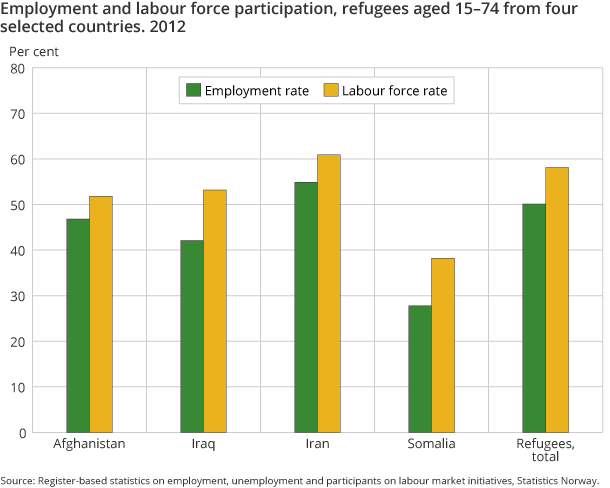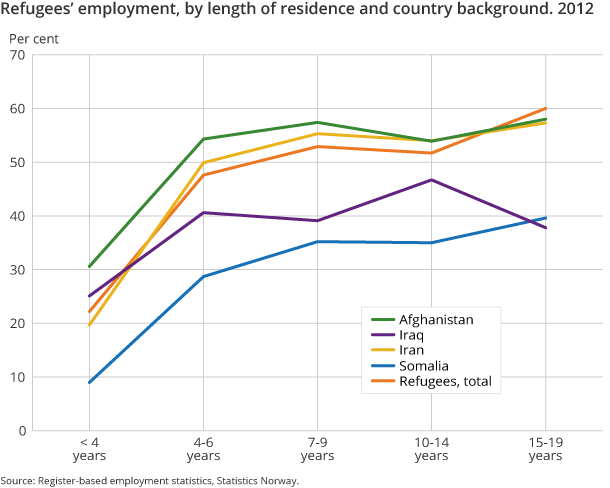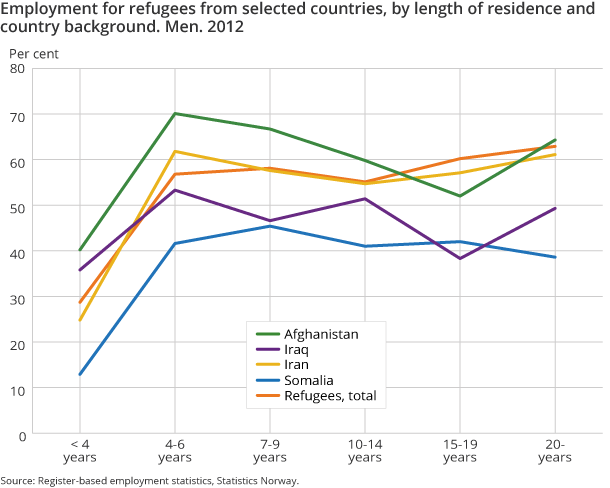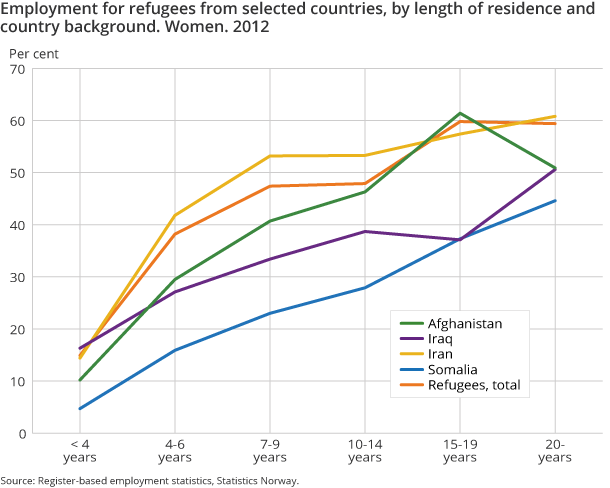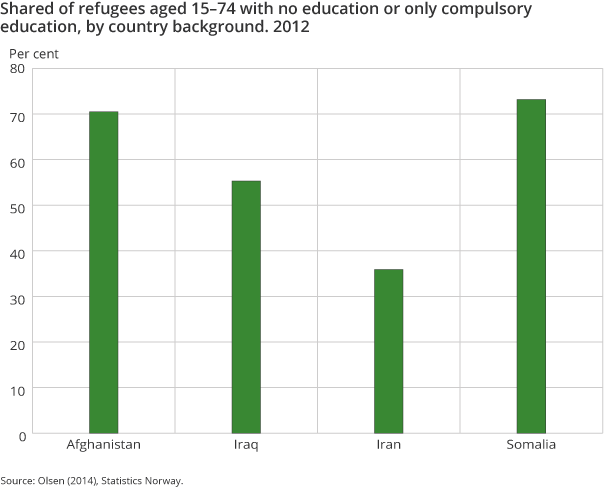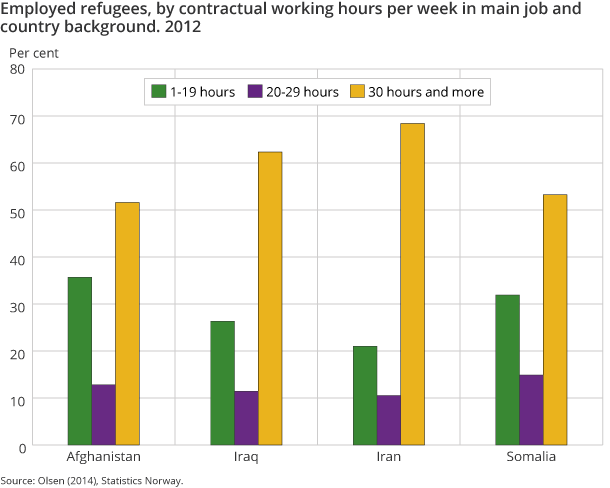Statistical analysis, 2017
Refugees in the labour market
Work – goal and arena for integration
Published:
This article was first published in Norwegian, in Statistics Norway’s journal Samfunnsspeilet: Næsheim, Helge Nome (2016): Flyktninger på arbeidsmarkedet. Arbeid – mål og arena for integrering. Samfunnsspeilet 4/2016. Statistisk sentralbyrå.
To become employed and integrated at the workplace is a key political objective towards refugees when they settle in the municipalities. Labour force participation among refugees from Afghanistan, Iraq, Iran and Somalia – four major groups in Norway – varies considerably, and is very low for some groups. However, the picture is somewhat less dramatic when we consider different aspects of this, such as length of residence and gender.
- Series archive
- Statistical analysis, 2017
Being a part of working life is an important element of the broad concept of integration. For the individual, the main aspect of working is the opportunity to earn an income. This is illustrated in the article by Tom Kornstad about self-support in this issue of Samfunnsspeilet. The workplace is also important because it allows employees to make use of their skills and expertise and socialise with others.
For refugees (see the box for definition), work is also important because it provides an arena for them to practise their Norwegian. Employment is of a crucial importance for the society as it contributes to the production of goods and services, generates tax revenues and reduces the need for welfare benefits.
Employment or labour force?
Participation in the labour market is often presented as the employment rate, i.e. the percentage of a group in the population that has paid employment or is self-employed. When measuring labour market participation, it is actually more common to look at the labour force, i.e. the percentage of the population that is not only in work but that has tried to find work and is ready to start working.
Persons in employment are those in the labour force who have succeeded in finding work, while the unemployed are those who have not been successful. Thus, the labour force is an expression of the sub-population that offers its labour to employers. In relation to the goal of integration, there is a difference between those who actively try to find work and those who are less active or not trying at all.
Quantifying unemployment
For refugees and other immigrants, public registers are now the main source of employment and unemployment figures. The employment data is accurate enough to use, while the figures on the unemployed are somewhat underestimated. For example, they do not include jobseekers who are not registered with the Norwegian Labour and Welfare Administration (NAV).
The Labour Force Survey (LFS), which is an interview-based survey conducted by Statistics Norway, captures the overall unemployment rate. The drawback with this is that it has a certain bias as a result of a high non-response rate among some immigrant groups, and because the sample is too small to analyse refugees from certain countries, as in this article. Nevertheless, we believe that using register figures on unemployment for the relevant four countries does not significantly affect the comparability between them.
In addition to figures on registered unemployment, NAV has figures on participants in labour market measures. These are also jobseekers. Strictly speaking, those on employment measures should have been excluded, since in theory they are already counted in the employment rate, but the share on such measures is small and has little impact on the comparison between the groups. The figures used in the article are mainly taken from the report on refugees in the labour market in the fourth quarter of 2012 (Flyktninger og arbeidsmarkedet, 4. kvartal 2012, Olsen 2014).
Longer in Norway – more in work
Among the four refugee groups in our analysis, refugees from Somalia have by far the smallest share in employment, while Iran has a much larger share than the others, according to figures for 2012 (Figure 1). When we add to this the so-called gross unemployed (registered unemployed plus participants of labour market initiatives), we see that the disparity is considerably less. The groups with the smallest share in work are those with the highest gross unemployment.
Much of this disparity is related to the fact that the length of residence in Norway differs considerably between the four groups of refugees in our analysis. The share of refugees from Somalia and Afghanistan with a length of residence of less than four years, is three times higher than for their counterparts from Iran. When refugees first arrive in Norway, much of their time is spent on the introduction programme, after which many will start looking for work. The share of gross unemployment among refugees from Somalia in 2012 was therefore 10 per cent, while the corresponding figure for those from Iran was 6 per cent.
In general, we know that the share of refugees who are in employment varies in line with the number of years they have lived in Norway. Figure 2 shows how the share in 2012 varied with length of residence for the four groups by country background and refugees in total.
Gender disparity
After the initial years of establishment, the share in employment sees a marked rise and then levels off. However, there are clear gender disparities here, which we discuss below. Participation in the labour market subsequently falls among those with a very long period of residence, but this is because many will be approaching an age where disability benefits become more common, and many will also be starting to retire.
Employment is naturally very low for all groups during the first four years in Norway, as shown in Figure 2. The large variation in 2012 in the shares among the four groups after such a short period of residence explains much of the major disparity in the overall employment rate. In 2012, 28 per cent of refugees from Somalia had lived in Norway for less than four years, while the corresponding share for Iran was 10 per cent. The disparity in employment rates between refugees from Somalia and Iran was 27 percentage points when we include everyone regardless of length of residence. There is still a large disparity when we consider each of the length of residence intervals in the figure, but it is now reduced to around 20 percentage points.
Women take longer, but eventually reach the same level as men
There are major gender disparities in both the level of employment in 2012 and the development of the share in employment by length of residence (see Figures 3 and 4).
Common to all four refugee groups in the analysis is that the share of employed men rises sharply during their first years in Norway, then levels out after 6–7 years (Figure 3). For women, the share is significantly smaller than for the men during the initial period, but then rises steadily from period to period (Figure 4). This also means that the gender disparities level out markedly over time. Women from Somalia whose length of residence is more than 20 years end up with a slightly higher employment rate than men.
New project will give a more nuanced picture
One factor that can help to explain the disparities between the four groups of refugees and between men and women is age. We do not have such material available for this article, but the age aspect will be factored into an ongoing project in Statistics Norway. The project, which will conclude with a report in 2017, follows refugees from the same four countries, but in this case those who were settled from 2001 to 2002. This means that the project follows the same refugee cohort over time, which gives the same length of residence for all.
The project also takes into account the age distribution when mapping variations in the speed of integration into the labour market by country background, whether it flattens out at different levels, and whether it falls again in a similar pattern. The main purpose of the project is to develop a general plan for how data can best be utilised and adapted to follow the integration of new refugee cohorts in the labour market.
Education first, then work?
As already discussed, age and length of residence have a large bearing on employment prospects. Age is, of course, not only pertinent to the refugees; employment also has a strong correlation to age among non-immigrants in Norway. Labour market statistics provide figures for those as young as 15, and for the youngest group, taking an education is more or less vital to finding employment. After upper secondary school, continuing in education rather than taking up employment is considered an advantage rather than a disadvantage.
Attending education instead of seeking work will not hinder a refugee’s integration, and indeed will improve their chances of finding work. The correlation between age and educational activity is not as strong for refugees as for the rest of the population. Many adult refugees come to Norway with little education, in which case taking an education during their first years in Norway will be an advantage, and often necessary, in their subsequent search for work.
Statistics Norway currently lacks individual data on adults who are in primary/lower secondary education. We do not therefore have information on all refugees who participate in educational activities. This will particularly have an impact on the countries where the share with no education or a very low level of education is highest.
Figure 5 shows the share who have either not completed a primary/lower secondary education or where this is their highest level of completed education, calculated as a percentage of those for whom education data is available. (There is also a relatively high number for whom no education data is available.) This share is highest for Somalia and Afghanistan, country backgrounds where education levels are lowest for those whose education is known.
The ongoing project where we follow refugee cohorts from 2001 to 2002 indicates that among those with an unknown education, the share with an upper secondary or higher education is larger for Afghans than Somalis.
Refugees’ education from their homeland is presented in more detail in the article by Hanne K. Bjugstad and Anne Marie Holseter in this issue of Samfunnsspeilet.
Employed – for how many hours?
So far, we have examined integration in the labour market/education based on whether the refugees participate or not. A more in-depth analysis can be made of employment by examining working hours.
The share of employed refugees with less than 20 contractual working hours is highest for Somalis and Afghans (see Figure 6). One reason for this may be that many of the employed persons from these countries are in education, and that employment is secondary to studying. The lower level of education among refugees from these countries supports this assumption.
Another possible explanation is that refugees from these countries have a higher degree of attachment to the labour market than others through multiple small jobs. Their main job therefore has fewer hours.
The disparity is less than envisaged
The disparity in labour market integration between refugees from Afghanistan, Iraq, Iran and Somalia is considerably less when we factor in the different lengths of residence. If we exclude those with the shortest period of residence, the disparity in the share in employment is also considerably smaller compared with the population as a whole. For refugees from Iran, where very few have short periods of residence, this has little significance, but this is also the group by country background with the largest share in employment among the four groups.
Common to all four countries is that men are quicker to find work than women, but that the disparities are offset as length of residence increases. Participation in education should be considered a natural path to employment for refugees in the same way as for the general population, particularly for those with little schooling from their homeland.
References
Olsen, Bjørn. (2014). Flyktninger og arbeidsmarkedet, 4.kvartal 2012. (Reports 2014/6). http://www.ssb.no/arbeid-og-lonn/artikler-og-publikasjoner/flyktninger-og-arbeidsmarkedet-4.kvartal-2012
Contact
-
Statistics Norway's Information Centre

